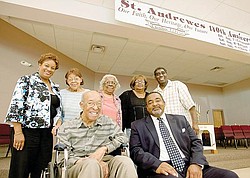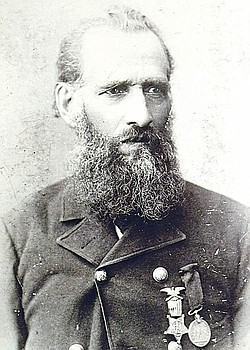St. Andrewes: Foundation of faith
St. Andrewes African Methodist Episcopal Church, 521 W. Earle Ave., Youngstown, will mark its 140th anniversary during a three-day observance next weekend. Celebrants at the oldest church of black American heritage in Mahoning County are, from left seated, Stanley W. Payne, trustee, and the Rev. Dr. Steven A. Jackson, pastor. Back left, Tuana Bennett-Vinson, anniversary chairwoman; Louise F. Payne, anniversary committee; Annie Brown, trustee; Judy Tarver, steward; and Steffon W. Jones, historian.
Old photographs will be among memorabilia shared at the 140th anniversary of St. Andrews African Methodist Episcopal Church in Youngstown. Pictured here is Oscar Dureth Boggess, one of the original 15 founders of St. Andrews AME Church.
Its name has changed three times because of moves, and pieces of its history were lost in relocations. But that’s not as important as the faith, fortitude and family of St. Andrewes African Methodist Episcopal Church, which continues to stand firm.
The church, the oldest of black American heritage in Mahoning County, is marking its 140th year with a three-day celebration next weekend. Church members, present and past, and a host of friends will celebrate at the events.
Its history plays a role in Youngstown, Mahoning County and the Western Reserve and has ties to the Civil War.
Recently, the Rev. Dr. Steven A. Jackson, pastor; Stanley W. Payne, trustee, and his wife, Louise F., anniversary committee member; Annie Brown, trustee; Steffon Wydell Jones, historian; Judy Tarver, steward; and Tuana Bennett-Vinson, anniversary committee chairwoman, gathered to talk about the church’s past, present and future.
With America divided after the Civil War, some former slaves and veterans settled in Youngstown. In 1869, some of them were among the 15 people who started a mission church. It became Mill Street AME Church when it was accepted into the AME Conference about 1871. The membership built its first structure in 1872.
When Mill Street was renamed Oak Hill Avenue in 1903, the church followed suit and became Oak Hill Avenue AME Church. Church history says that when the membership reached 750, the church had to be rebuilt in 1907 to hold the growing congregation.
“There were 15 charter members of the church,” Jones said, adding that all the names aren’t known exactly. Jones said he believes wives of some of the founders also participated but weren’t listed.
Oscar D. Boggess is among the founders. Others included Frank Leecce, John B. Holmes, Susan Holmes, Elijah Johnson, Richard Boggess, Watson A. Williams, P. Ross Berry, Mary M. Berry, Alfred Simpson and Julie Johnson.
In “History of Youngstown and the Mahoning Valley,” it is noted the church met at the homes of Oscar Boggess and John Holmes.
Jones said Oscar Boggess was a black Civil War soldier who is buried in Oak Hill Cemetery. Boggess, who died at 74 in 1907, was a sergeant in the 43rd Regiment, United States Colored Volunteers of Pennsylvania. He received a medal for his courage. Boggess moved to Youngstown in 1866.
Jones said an Ohio Historical Marker plaque dedicated to Boggess is at Hawthorne and Edwards streets, the area in which he lived.
As the years passed and the membership grew, the congregation of some 1,100 strong voted to buy the former El Emanuel Congregation Temple, 117 E. Rayen Ave.
Brown, who has been a member for 67 years, said she remembers one of the reasons for the move from Oak Hill Avenue to Rayen might have been the noise from the B&O Railroad. “The trains would come and you could hear them,” she said. “We outgrew the location.”
In the move during 1951, the church lost its Oak Hill connection, so a name change was in order. Brown said the name of St. Andrewes was selected. “It has a different spelling to differentiate between churches ... there was a St. Andrew’s Episcopal Church,” she said.
St. Andrewes remained on Rayen Avenue until the congregation decided to move again.
A Vindicator story in October 2002 noted that “a historical city church is returning to its roots and helping to revitalize the South Side.” The Rev. Jon Goshay, then pastor, noted the building would cost exactly $1 million. The church, now at 521 W. Earle Ave., where it moved in 2003, has a large fellowship hall, where worship occurs, and office space.
The Rev. Mr. Jackson said it was decided to build the hall first, which could be used for multiple purposes including fundraising. It seats about 400.
Stanley Payne’s connection to the church began in 1935, when his father, the Rev. Harrison G. Payne, was pastor. He admitted he liked the social elements of the church. “We had fun times on Sunday nights when we would gather,” he said.
His wife, Louise, has been a member for some 61 years. “I was superintendent of Sunday school and organized the Nursery Guild,” she said, noting the guild members took care of children during the morning service.
Louise Payne, Tarver and and Brown all cited the importance of the mission society, which helps missions around the world. The Pink Tea, one of the church’s most notable events, is a fundraiser for the church and missions.
Tarver said St. Andrewes is “mostly a black church,” though people of other ethnic backgrounds sometimes attend. “It’s part of our mission statement to be of service and help to the community,” she said.
Tarver said she appreciated the church’s history linked to former slaves finding freedom and freedom of religion. She recalled the beginning of the AME church, an outgrowth of the Free African Society led by Richard Allen and Absalom Jones in Philadelphia. “I know I can pray here and be on my knees, and no one will make me move,” she said. “It goes back to the roots of faith.”
Mr. Jackson said the AME church was founded because black Americans worshipping at a Philadelphia church were pulled away from their seats in one area and told to sit elsewhere. Social concerns remain a tenant of the church. “The anniversary will help us jump-start the community outreach of feeding and clothing programs,” he said.
The Paynes said they have stayed with St. Andrewes because it gives them “religious satisfaction.”
Brown said music is a major ministry within the church. “It’s communicating with the Lord,” she said.
Bennett-Vinson, who said she came to the church with her grandmother, noted that “this is a family-oriented church.”
Jones said the church has a special place in the history of the community. “It’s history, and it’s my future,” he said.
 43
43


